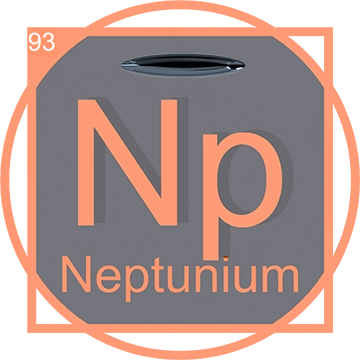Introduction to Neptunium
Neptunium is a synthetic, radioactive metallic element, represented by the symbol Np and atomic number 93 in the periodic table. As one of the first transuranic elements, Neptunium occupies a key position in the actinide series, known for its fascinating chemical and physical properties.
The Discovery of Neptunium

Neptunium was discovered by Edwin McMillan and Philip H. Abelson in 1940 at the Berkeley Radiation Laboratory. This groundbreaking discovery occurred during experiments with the cyclotron, where uranium-238 was bombarded with neutrons to eventually produce neptunium-239, marking the first discovery of an element beyond uranium in the periodic table.
Neptunium in the Periodic Table
As an actinide, Neptunium is situated among elements that are typically heavy and exhibit high radioactivity. It shares common properties with its neighbors in the periodic table, such as plutonium and uranium, which include high density, metallic luster, and reactivity.
Scientific Significance of Neptunium
Neptunium's scientific exploration has enhanced our understanding of nuclear reactions and nuclear structure. It serves as a stepping stone in the synthesis of heavier elements and plays a crucial role in research pertaining to nuclear energy and safety.
Applications of Neptunium in Technology

While Neptunium is not used extensively in everyday applications due to its radioactivity, it has niche uses in science and technology. One of its isotopes, Neptunium-237, is used in devices like radioisotope thermoelectric generators (RTGs), which are used in spacecraft. It also has potential applications in nuclear medicine and as a material for constructing nuclear weapons, although these uses are limited by international treaties and safety concerns.
Production and Sources of Neptunium
Neptunium is not naturally occurring in significant amounts on Earth and is primarily produced synthetically. It is typically generated in nuclear reactors through the neutron bombardment of uranium. When uranium-235 or uranium-238 absorbs a neutron, it forms uranium-239, which rapidly decays into neptunium-239 through beta decay.
As Neptunium is a byproduct of nuclear reactions, it is not mined from traditional mines but can be extracted from spent nuclear fuel, a process which also yields other valuable actinides such as plutonium and uranium.
Current Uses of Neptunium

Currently, one of the primary uses of Neptunium, specifically Neptunium-237, is in radioisotope thermoelectric generators (RTGs) used in spacecraft. This application takes advantage of its long half-life and ability to release considerable heat through radioactive decay, providing a reliable power source for long-duration space missions.
Neptunium is also utilized in the production of neptunium glass, which is used for specialized scientific equipment and in certain types of radiation detection equipment.
Future Prospects of Neptunium
The future of Neptunium is closely tied to advances in nuclear technology and energy. Researchers are investigating the potential of Neptunium-237 in breeding special types of nuclear fuel, which could be crucial for future breeder reactors. Such reactors are designed to generate more fissile material than they consume, potentially leading to a more sustainable nuclear energy system.
Additionally, the unique properties of Neptunium could lead to its increased use in nuclear medicine, particularly in cancer treatment, where its radioactive isotopes could be used to target and destroy malignant cells effectively.












